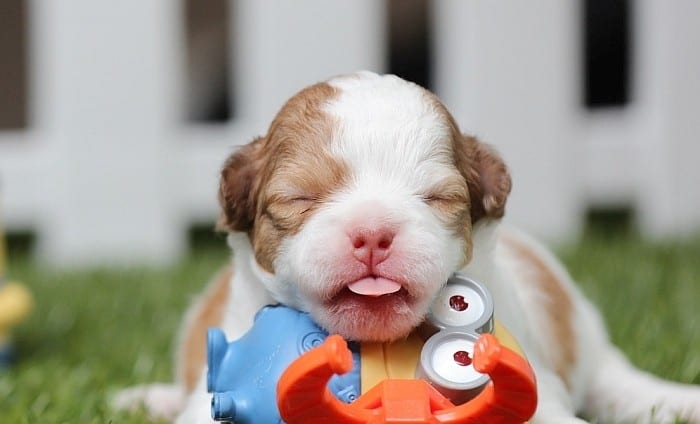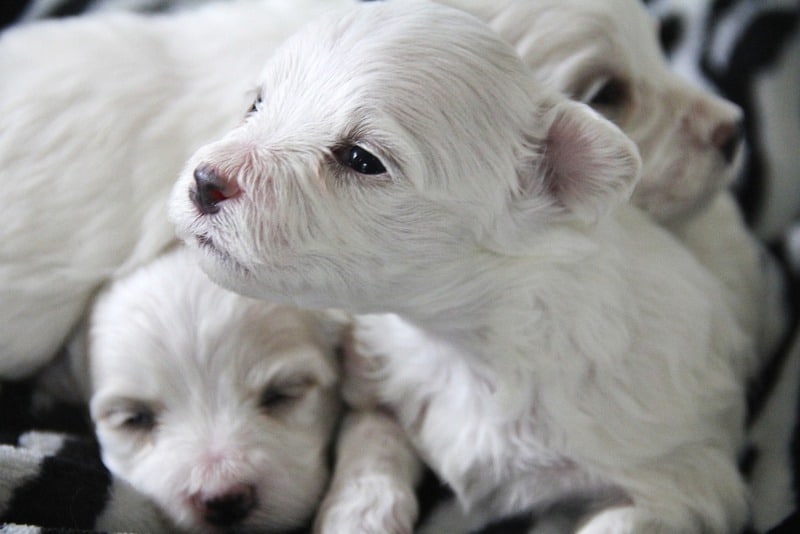What Breed Produces the Most Puppies?
As mentioned earlier, a dog’s size – and therefore her breed – is probably the most important single factor that influences litter size. Larger dogs produce larger litters, so it stands to reason that breeds with larger average size will produce more puppies than breeds with smaller average body size will.
Simply put, Great Danes will usually produce larger litters than Chihuahuas will. We can’t find a reliable study that has sought to determine the most fertile breed, but it is surely one of the largest ones, such as one of the mastiffs, Irish wolfhounds, or Great Danes.
However, it is a bit more difficult to determine which breed will usually produce the most puppies over the female’s entire lifetime. This is partially due to the fact that small dogs routinely live much longer than large breeds do. A Pomeranian may, for example, live to be 15 years of age, while Irish wolfhounds usually only live for about half as long.
So, while the Pomeranian’s litters are likely to be much smaller than those of a wolfhound, the Pomeranian will have the chance to produce many more litters over the course of her life.
Additionally, small breeds tend to experience their first heat at a younger age than larger breeds do (sometimes an entire year earlier). They also tend to cycle more quickly, which also makes them more likely to produce more litters than larger breeds.

What’s the Largest Litter Ever Recorded?
In 2004, a Neapolitan mastiff named Tia became the mother of the largest litter ever documented, when she delivered 24 puppies via Caesarian section.
This is obviously quite the anomaly, as most dogs produce much smaller litters than this. In fact, Neapolitan mastiff litters typically number between 6 and 10 puppies.
A few other notable cases involving huge litters include:
There are a number of different things that can influence the size of a dog’s litter, and we’ve detailed some of the most important ones below. It is difficult to empirically determine how much these various factors influence litter size, and it is likely that the various factors influence each other to some degree.
A dog’s breed is one of the most important factors influencing litter size. Simply put, larger breeds produce larger litters. That’s why Shih Tzus, Pomeranians and Chihuahuas have litters typically ranging from one to four puppies, while Cane Corsos, Great Danes, and other giant breeds often give birth to eight puppies or more.
Within a given breed, individuals with larger body sizes (in terms of build, not weight) typically give birth to larger litters. For example, a 45-pound Labrador retriever may produce a litter of only five or six puppies, while an 85-pound Lab may produce a litter of 10 or more.
While dogs typically remain fertile for their entire lives, they are most fecund during early adulthood – usually between 2 and 5 years of age. However, a dog’s first litter is generally smaller than subsequent litters.
Dogs in good health are more likely to produce larger litters, and they’re also more likely to produce healthy puppies. In fact, it is imperative that any female slated for breeding trials be in perfect health to ensure she and the puppies will survive the birthing and whelping process.
Diet likely has a strong influence on litter size. Feeding your dog a nutritious, well-balanced diet will likely yield larger litter sizes than feeding a homemade or poor-quality food.
The smaller a dog’s gene pool is, the smaller her litters will tend to be; conversely, dogs who come from more diverse backgrounds tend to have larger litters. This means that dogs from lines that have been inbred extensively will slowly develop smaller and smaller litters.
Dogs are all individuals, who vary in countless ways; sometimes, this can include litter size. This is very difficult to predict, but dogs who produce large first litters and likely to produce large second and third litters, assuming all other factors remain constant.
Note that most of these traits relate to the dam (female) rather than the sire (male). However, the sire does have some influence on the litter size. His health, age, and individual genetic makeup will partially determine the size of the litter he sires.

“Our staff and volunteers have been working tirelessly to ensure all the puppies have thrived, and they are now ready to start their journeys to becoming life-changing guide dogs for people with sight loss.”
“A litter of 16 is incredibly unusual, but such a gift,” Matthew Bottomley, head of breeding operations, said in the statement. “The pandemic has had a detrimental impact on our charitys breeding program and how many litters we can have, so these puppies are even more treasured.
The organization posted a video of the pups, accompanied by the message: “16 puppies incoming! Meet Konrad, Hugo, Clayton, Nash, Derek, Joel, Pax, Ranger, Denver, Evans, Ellie, Silvie, Mabel, Twiggy, Betty and Daisy. Thats right, 16 little life-changers!”
Unitys impressive litter is twice the average of eight puppies for German shepherds, according to the purebred registry of the American Kennel Club, which lists the largest known litter for the breed at 17 puppies. Across all breeds, the organization reports an average litter size of 5 or 6 puppies, with a normal range of one to 12 puppies.
The puppies were born to Unity, a 3-year-old German shepherd, and sired by Trigger, a 6-year-old golden retriever. They were delivered at the organizations National Center near Leamington Spa in Warwickshire.
Couple Has No Idea Their Foster Dog Is Pregnant With Tons Of Puppies | The Dodo Foster Diaries
The litter was over twice the size of a usual German Shepherd’s and set a new mark for charity Guide Dogs
Calling all dog lovers! Sign up to our TeamDogs newsletter for your weekly dose of dog news, pictures and stories
A three-year-old German Shepherd in the care of Guide Dogs has given birth to an astounding 16 puppies in one litter.
The litter of German Shepherd cross Golden Retriever puppies has set a new record for the charity’s 60-year-old breeding programme.
Despite it being mum Unity’s first litter, she gave birth to more than half the size of an average German Shepherd litter, which is eight, and triple the size of an average litter for any dog which is five or six.
The six-year-old has sired 28 litters to date, producing 239 puppies and making him the charity’s most prolific stud dog.
It is hoped these crossbreed puppies will have the loyalty and drive of a German Shepherd, and the friendliness and confidence of a golden retriever.
Aesthetically, the puppies are dark with medium-length fur, and some have golden tinges dappled around their faces and bodies.
The puppies are no with their volunteer puppy walkers, and have been named Konrad, Hugo, Clayton, Nash, Derek, Joel, Pax, Ranger, Denver, Evans, Ellie, Silvie, Mabel, Twiggy, Betty and Daisy.
Guide Dogs is proud to run the biggest and most ethical programme of working dogs in the world by meticulously health testing all of its breeding dogs who live with volunteers, so each puppy has the best start in a loving home environment.
The next step for the puppies is to come into the Guide Dogs National Centre near Leamington Spa for one week before being individually placed with Puppy Trainers across the UK, as these 16 now have.
Matthew Bottomley, head of breeding operations at Guide Dogs said: “A litter of sixteen is incredibly unusual, but such a gift.
“The pandemic has had a detrimental impact on our charity’s breeding programme and how many litters we can have, so these puppies are even more treasured.
“Our staff and volunteers have been working tirelessly to ensure all the puppies have thrived and they are now ready to start their journeys to becoming life-changing guide dogs for people with sight loss.”
To find out more and support the scheme by sponsoring a puppy, visit Guide Dogs’ website .